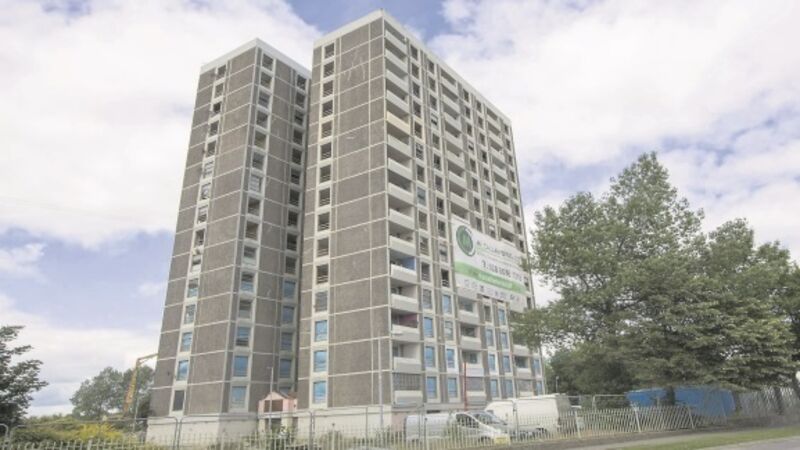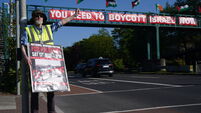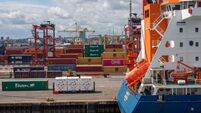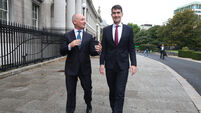Ballymun: From high hopes to broken dreams

As the last of the notorious tower blocks face imminent demolition, there is the sense that Ballymun is coming full circle. In a few months the community will mark the 50th anniversary of the high-rise North Dublin estate, conceived by the local government minister, Neil Blaney, as a solution to the housing crisis in the inner city, characterised by squalor and overcrowding.
In 1966 Ballymun seemed state of the art. Ballymun consisted of seven 15-storey tower blocks. Rising at intervals around them were 19 eight-storey spine blocks and 10 four-storey walk-up flats.
“It was better in the ’60s,” recalls housewife Rachael McGurk sadly, looking over towards the empty tower block, “everybody wanted to live here then.”
But within a few years failure to maintain these flats was evident. Stairwells and lift shafts were filthy and festooned with graffiti, with trails of discarded syringes.

“They started putting antisocial people from other areas into Ballymun,” remembers resident Debbie Fox, “the drugs epidemic really got bad around 1985.” Next year the nation will mark a century since the execution of Dublin’s Easter Rising signatories. Executions of a different kind (demolitions) have been ongoing for some time now. By 2016 the last of the patriotically named seven towers — Plunkett — is expected to have been demolished. But next year would ideally have marked a decade since ‘regeneration’ was finally wound up. That at least was the date set by the 1998 masterplan, one year after Dublin City Council set up Ballymun Regeneration Ltd (BRL), a company tasked with implementing the plan.
The regeneration cost €1.5bn: Over budget and over schedule. Nevertheless, says BRL’s former managing director, Ciaran Murray: “Ballymun set a new standard in so far as it addressed, in an integrated way, the social and economic issues.
“And while it didn’t deliver as many jobs as we would have hoped, certainly Ikea, certainly getting the neighbourhood involved, active, getting a lot of old families relocated, getting Garda (Divisional) head quarters for the area, moving it from an industrial estate into Ballymun, getting the health board to move to a primary care centre; I think they’re all very significant. I don’t know any other regeneration anywhere who can hold a candle to what has been achieved in Ballymun.”
Talk of the council establishing a Ballymun Civic Alliance recalls the consultative bodies of the last decade. The regeneration came about following years of social activism by community groups and organisations, advocating for issues such as maintenance, jobs, and the drug abuse epidemic. Once the regeneration was under way, it was hoped these groups would contribute to the revitalisation of the community. Many locals complained that subsequent consultative forums designed to interface with BRL were, in the words of former Housing Taskforce activist Willie Lee, “just a talking shop really. In my own opinion, we just had minor influence and that was all. I mean we were called a consultation, there was consultation alright. But you would give your views but they were very seldom listened to.”
Meanwhile, many locals wonder about the dearth of essential services and investment in the community. In its original incarnation Ballymun was as big as many middle-sized Irish towns. Yet there was just one supermarket, two pubs, a part-time bank, and about two dozen ‘shops’ housed in containers.
“From the day Ballymun was built, there was promises made and nothing ever done,” Mr Lee says of the traditional neglect of the estate.
Just where a lot of the monies connected with the regeneration came from or went is uncertain. The report of the Comptroller and Auditor General says that the “bulk of funding for the programme is provided through the vote of the Department of the Environment, Heritage, and Local Government”. In addition the document states that funding would be due to a “wide range of other agencies and groups” and that the programme would also target private investment under the 1998 Urban Renewal Scheme. But the document is notable for its relative brevity. It does not include a breakdown of costs relating to a planned technology park and a new shopping centre.

Disputes over the latter have twice stalled the building of a new shopping centre. Unlike Tallaght and Dundrum, Ballymun has not seen the building of a large shopping centre. Instead a 1960s-era complex is largely derelict, almost all of its approximately 45 units empty. For a few years, Nama owned the facility; in May 2014 Dublin City Council acquired a remaining 53% stake in the centre.
On June 21, as if to emphasise the obsolete nature of the complex, a fire broke out at the site of the old Towers Pub and spread into the complex. Although brought under control within 90 minutes, the blaze caused extensive damage.

According to local councillors, the sale of the land immediately north of the old site has been sold to a developer subject to planning.
“Three shops and a cafe and that’s about the size of what you’re going to be getting for replacing the shopping centre,” says local resident Tony Greene, “but a lot of people are concerned about the fact that there’s going to be a lot of vacant land up here, left lying. With the economic upturn, will it be sold again? We’ll be back to the old days of prime land being sold.”
Cllr Paul McAuliffe (FF) suggests that these may also include residential units. “We sought, directly from the developer, a commitment that he would include residentials as part of it,” he says
“He was reluctant to agree to that because he felt that the cost for building apartments in Dublin at the moment is very high. And he wouldn’t realise that cost, so he wanted to have a mix of retail and office.”
On April 28, 2005, the now defunct local paper Ballymun Concrete News reported that phase one of a “€300m shopping centre” was to begin that June and “over 1,000 jobs” would “go to local people during construction and on completion”.
Mr Murray says: “It was very much an evolving situation. I genuinely don’t believe the price of land was an issue. The real issue was Treasury’s ambitions to expand and then the delay in Metro North going ahead.”
That is not the recollection of Murray Adair, senior development director who joined Treasury in 2004, when, he says, it had already agreed to purchase the land north of the current shopping centre for €25m. “Treasury acted in good faith and with the intention to proceed with the project as the precedent conditions were met,” he says, adding that the council then asked for an extra €50m.
“This was a death blow to the project as it completely killed viability and also the credibility of the council to act in good faith. It was also felt to be quite incredible that lands valued at what was even then a very high price could have tripled in two years.”

Cllr Andrew Montague (Lab), a former board member of BRL, seemed confused as to who was seeking the €75m. “Treasury were anything but co-operative, they were threatening, they were coercive and they did not, in my opinion, have the interests of community at heart,” he says.
“My memory is that [Treasury] were looking for €75m as opposed to the €25m that was originally touted. The figures of €25m and €75m are what I had in my mind but, one way or another, the community were going to lose out if the original plans were for €25m.”
Traditionally the shopping centre has acted as a hub for the community. As it now lies empty, Dublin City Council has provided free transport for elderly and disabled residents through ‘Vantastic,’ a charity mini bus that takes them to nearby Omni shopping centre for weekly shopping.
It is often assumed by outsiders that the regeneration was hobbled by the crash of 2008. But major investments and employment prospects failed to materialise even during the years of the building boom. There is the large furniture store run by Scandinavian chain Ikea, which employs a few locals.
In 2001 a business and technology park was to be located at the M50 junction and developed by Green Property. According to a senior figure in Green Property, the demand was not there for office space and BRL repaid the €5m in development costs to Green Property.
“What would have happened if it had been was that the crash would simply have bankrupted everybody but I’m surprised nothing happened in the period between when we walked away in around 2001 and when it all went pear-shaped in 2007-8,” he says.
Ironically, one project in Ballymun, contemporary to the regeneration has largely been a success. The Ballymun Arts & Community Resource Centre Axis Community and Resource Centre was not part of the regeneration process, which incorporates a theatre, recording studio cafe, and crèche. The Axis Centre, a €6m project, most of which came from the EU Urban programme, has replaced the shopping centre as the estate’s hub.
Ballymun may look different today but some residents wonder if the past represents the future.
Debbie Fox remembers the community banding together in the 1980s and 1990s over drug pushers and maintenance issues. Now amid concern about unemployment and cutbacks to services, she wonders if “the community is just going back the way it was”.













